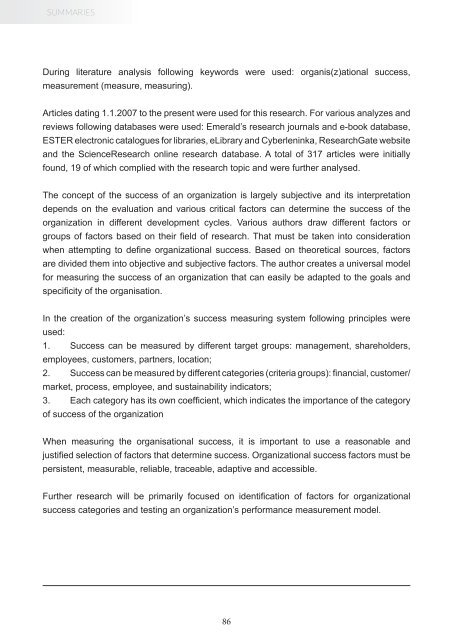TA_kogumik 2018-2019
You also want an ePaper? Increase the reach of your titles
YUMPU automatically turns print PDFs into web optimized ePapers that Google loves.
SUMMARIES<br />
SUMMARIES<br />
During literature analysis following keywords were used: organis(z)ational success,<br />
measurement (measure, measuring).<br />
Articles dating 1.1.2007 to the present were used for this research. For various analyzes and<br />
reviews following databases were used: Emerald’s research journals and e-book database,<br />
ESTER electronic catalogues for libraries, eLibrary and Cyberleninka, ResearchGate website<br />
and the ScienceResearch online research database. A total of 317 articles were initially<br />
found, 19 of which complied with the research topic and were further analysed.<br />
The concept of the success of an organization is largely subjective and its interpretation<br />
depends on the evaluation and various critical factors can determine the success of the<br />
organization in different development cycles. Various authors draw different factors or<br />
groups of factors based on their field of research. That must be taken into consideration<br />
when attempting to define organizational success. Based on theoretical sources, factors<br />
are divided them into objective and subjective factors. The author creates a universal model<br />
for measuring the success of an organization that can easily be adapted to the goals and<br />
specificity of the organisation.<br />
In the creation of the organization’s success measuring system following principles were<br />
used:<br />
1. Success can be measured by different target groups: management, shareholders,<br />
employees, customers, partners, location;<br />
2. Success can be measured by different categories (criteria groups): financial, customer/<br />
market, process, employee, and sustainability indicators;<br />
3. Each category has its own coefficient, which indicates the importance of the category<br />
of success of the organization<br />
When measuring the organisational success, it is important to use a reasonable and<br />
justified selection of factors that determine success. Organizational success factors must be<br />
persistent, measurable, reliable, traceable, adaptive and accessible.<br />
Further research will be primarily focused on identification of factors for organizational<br />
success categories and testing an organization’s performance measurement model.<br />
Martin Lints<br />
Non-destructive testing of carbon fibre reinforced polymer<br />
components<br />
This paper, titled “Non-destructive testing of carbon fibre reinforced polymer components”,<br />
considers the impact that Carbon Fibre Reinforced Polymer (CFRP) has to sustainable deve-<br />
lopment, now and in the future. While the use of CFRP materials in vehicles and machinery<br />
enhances their efficiency by reducing mass, it also has a considerable downside: it is difficult<br />
to recycle, therefore we would like to keep a CFRP part in service as long as possible. On<br />
the other hand, as it is used more and more in highly responsible and demanding tasks,<br />
such as in load-bearing structures, any damage must be detected early to minimize any<br />
dangerous breakdowns.<br />
The solution is to continuously conduct ultrasonic Non-Destructive Testing (NDT). It is,<br />
however, problematic, because NDT of composites is difficult due to: 1) internal structure of<br />
material inhibiting the traversal of acoustic waves in the material and 2) the spatial dimen-<br />
sions of possible defects, such as delaminations, can be smaller than the used wavelenght,<br />
making it invisible to the most used linear ultrasonic spectroscopy.<br />
This paper proposes to solve the problem, by: 1) turning the internal structure of the material<br />
to an advantage by using delayed Time Reversal – Nonlinear Elastic Wave Spectroscopy to<br />
focus the ultrasonic waves in the material, thereby increasing the signal-to-noise ratio; and<br />
2) detecting defects which are smaller than wavelength by their nonlinear effects.<br />
This signal processing method is tested by both physical experiments and numerical simula-<br />
tions. The link between the experiments and simulations is validated for undamaged material<br />
and then the effect of damage and its detectability is studied using the simulation model with<br />
a defect of various sizes. It is found that the signal processing method is well suited for<br />
composite materials, where waves have trouble traversing. Even more, the signal processing<br />
method can detect the nonlinear effects from crack which is smaller than the wavelength of<br />
the ultrasonic material.<br />
This signal processing method is therefore suitable for NDT of CFRP materials, enabling its<br />
wider and more efficient use in safety-critical applications without compromise in safety or<br />
economic cost, but decreasing the impact we have on the environment.<br />
86 87


